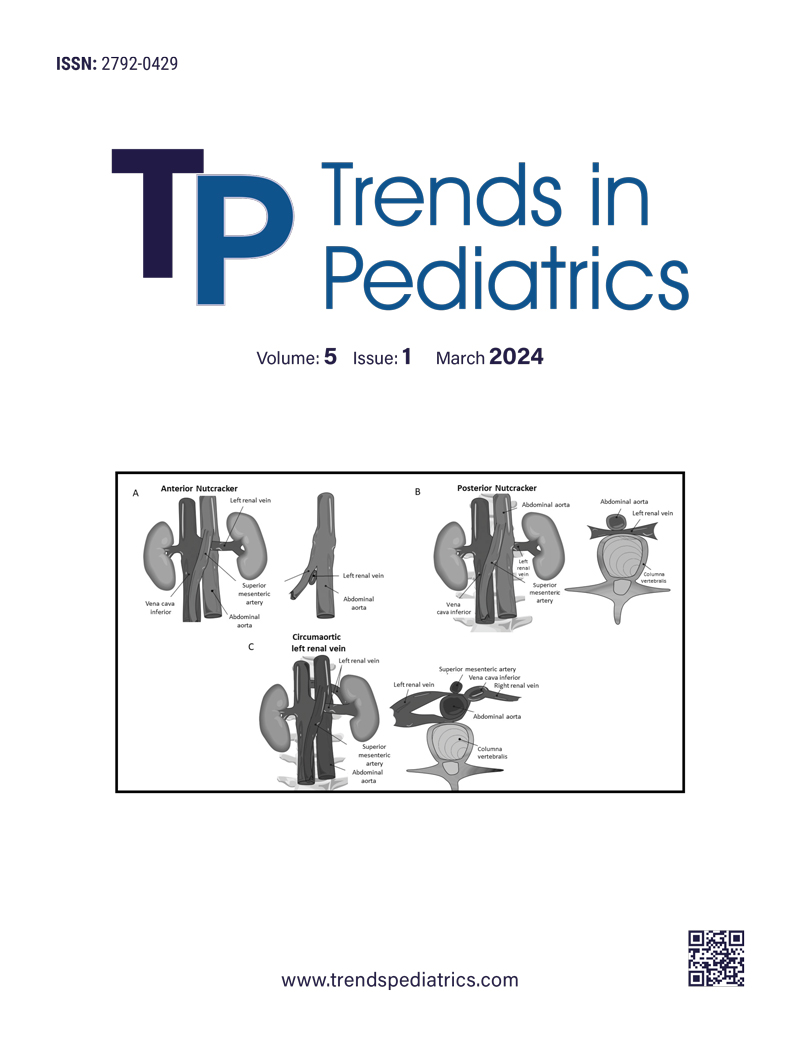Abstract
Nutcracker phenomenon (NP) is defined as the compression of the left renal vein, often occurring between the aorta and the superior mesenteric artery (SMA). Patients with symptoms associated with the Nutcracker anatomy are called “Nutcracker syndrome” (NCS). Renal vein compression results in venous congestion, outlet obstruction, and increased pressure in the left renal vein. The clinical manifestations of NCS in children vary widely depending on the severity of compression. It can range from being asymptomatic to presenting with intermittent or persistent micro or macrohematuria, orthostatic proteinuria, renovascular hypertension, abdominal pain, left-sided flank pain, dysmenorrhea, pain in the testicles or scrotum, and left varicocele. Hematuria, proteinuria, and flank pain are prevalent symptoms. The anatomical and physiological degree of compression of the left renal vein can be diagnosed through Doppler ultrasound (DUS), computer tomography (CT) scan, or magnetic resonance imaging (MRI). In cases with mild symptoms, conservative treatment is an appropriate option, and ACE inhibitors can be used for patients with proteinuria. In more severe cases where conservative approaches and medical treatment fail to yield satisfactory results, endovascular, laparoscopic, or open surgical interventions are employed.
Keywords: Nutcracker phenomenon, Nutcracker syndrome, left renal vein entrapment, hematuria, orthostatic proteinuria
Copyright and license
Copyright © 2024 The author(s). This is an open-access article published by Aydın Pediatric Society under the terms of the Creative Commons Attribution License (CC BY) which permits unrestricted use, distribution, and reproduction in any medium or format, provided the original work is properly cited.
How to cite
References
- El-Sadr AR, Mina E. Anatomical and surgical aspects in the operative management of varicocele. Urol Cutaneous Rev. 1950;54:257-62.
- de Schepper A. "Nutcracker" phenomenon of the renal vein and venous pathology of the left kidney. J Belge Radiol. 1972;55:507-11.
- Gulleroglu K, Gulleroglu B, Baskin E. Nutcracker syndrome. World J Nephrol. 2014;3:277-81. https://doi.org/10.5527/wjn.v3.i4.277
- He Y, Wu Z, Chen S, et al. Nutcracker syndrome--how well do we know it? Urology. 2014;83:12-7. https://doi.org/10.1016/j.urology.2013.08.033
- Meyer J, Rother U, Stehr M, Meyer A. Nutcracker syndrome in children: Appearance, diagnostics, and treatment - A systematic review. J Pediatr Surg. 2022;57:716-22. https://doi.org/10.1016/j.jpedsurg.2021.12.019
- Matsukura H, Arai M, Miyawaki T. Nutcracker phenomenon in two siblings of a Japanese family. Pediatr Nephrol. 2005;20:237-8. https://doi.org/10.1007/s00467-004-1682-y
- Kurklinsky AK, Rooke TW. Nutcracker phenomenon and nutcracker syndrome. Mayo Clin Proc. 2010;85:552-9. https://doi.org/10.4065/mcp.2009.0586
- Lee S, Kim W, Kang KP, Kwak HS, Park SK. Microscopic hematuria and the posterior nutcracker phenomenon. Kidney Int. 2007;72:1037. https://doi.org/10.1038/sj.ki.5002415
- Visschere P, Man R, Rosseel F, Crolla D, Verstraete K, Villeirs G. Combined anterior and posterior nutcracker phenomenon in circumaortic left renal vein. Eurorad. 2008. Available at: https://www.eurorad.org/case/6962
- Kolber MK, Cui Z, Chen CK, Habibollahi P, Kalva SP. Nutcracker syndrome: diagnosis and therapy. Cardiovasc Diagn Ther. 2021;11:1140-9. https://doi.org/10.21037/cdt-20-160
- Granata A, Distefano G, Sturiale A, et al. From Nutcracker Phenomenon to Nutcracker Syndrome: A Pictorial Review. Diagnostics (Basel). 2021;11:101. https://doi.org/10.3390/diagnostics11010101
- Shin JI, Park JM, Lee SM, et al. Factors affecting spontaneous resolution of hematuria in childhood nutcracker syndrome. Pediatr Nephrol. 2005;20:609-13. https://doi.org/10.1007/s00467-004-1799-z
- Venkatachalam S, Bumpus K, Kapadia SR, Gray B, Lyden S, Shishehbor MH. The nutcracker syndrome. Ann Vasc Surg. 2011;25:1154-64. https://doi.org/10.1016/j.avsg.2011.01.002
- Mahmood SK, Oliveira GR, Rosovsky RP. An easily missed diagnosis: flank pain and nutcracker syndrome. BMJ Case Rep. 2013;2013:bcr2013009447. https://doi.org/10.1136/bcr-2013-009447
- Vianello FA, Mazzoni MB, Peeters GG, et al. Micro- and macroscopic hematuria caused by renal vein entrapment: systematic review of the literature. Pediatr Nephrol. 2016;31:175-84. https://doi.org/10.1007/s00467-015-3045-2
- Mazzoni MB, Kottanatu L, Simonetti GD, et al. Renal vein obstruction and orthostatic proteinuria: a review. Nephrol Dial Transplant. 2011;26:562-5. https://doi.org/10.1093/ndt/gfq444
- Pascarella L, Penn A, Schmid-Schönbein GW. Venous hypertension and the inflammatory cascade: major manifestations and trigger mechanisms. Angiology. 2005;56(Suppl 1):S3-10. https://doi.org/10.1177/00033197050560i102
- Agarwal A, Litra F, Barr LL. A Rare Cause of Abdominal and Flank Pain in Children: Nutcracker Syndrome. Cureus. 2021;13:e16422. https://doi.org/10.7759/cureus.16422
- Alaygut D, Bayram M, Soylu A, Cakmakcı H, Türkmen M, Kavukcu S. Clinical course of children with nutcracker syndrome. Urology. 2013;82:686-90. https://doi.org/10.1016/j.urology.2013.03.048
- Waldrop RD, Henning P. Nutcracker Syndrome Masquerading as Renal Colic in an Adolescent Athlete: A Case Report. Clin Pract Cases Emerg Med. 2021;5:415-8. https://doi.org/10.5811/cpcem.2021.6.52140
- Wang RF, Zhou CZ, Fu YQ, Lv WF. Nutcracker syndrome accompanied by hypertension: a case report and literature review. J Int Med Res. 2021;49:300060520985733. https://doi.org/10.1177/0300060520985733
- Hohenfellner M, Steinbach F, Schultz-Lampel D, et al. The nutcracker syndrome: new aspects of pathophysiology, diagnosis and treatment. J Urol. 1991;146:685-8. https://doi.org/10.1016/s0022-5347(17)37893-x
- Cioffi S, Di Domenico F, Russo G, et al. Diagnostic Clues in Pediatric Nutcracker Syndrome: From Two Clinical Cases to Current Literature Analysis. Children (Basel). 2022;9:1988. https://doi.org/10.3390/children9121988
- Ananthan K, Onida S, Davies AH. Nutcracker Syndrome: An Update on Current Diagnostic Criteria and Management Guidelines. Eur J Vasc Endovasc Surg. 2017;53:886-94. https://doi.org/10.1016/j.ejvs.2017.02.015
- Arthurs OJ, Mehta U, Set PA. Nutcracker and SMA syndromes: What is the normal SMA angle in children? Eur J Radiol. 2012;81:e854-61. https://doi.org/10.1016/j.ejrad.2012.04.010
- Zhang H, Li M, Jin W, San P, Xu P, Pan S. The left renal entrapment syndrome: diagnosis and treatment. Ann Vasc Surg. 2007;21:198-203. https://doi.org/10.1016/j.avsg.2006.10.021
- Miró I, Serrano A, Pérez-Ardavín J, et al. Eighteen years of experience with pediatric nutcracker syndrome: the importance of the conservative approach. J Pediatr Urol. 2020;16:218.e1-e6. https://doi.org/10.1016/j.jpurol.2019.12.003
- Chen W, Chu J, Yang JY, et al. Endovascular stent placement for the treatment of nutcracker phenomenon in three pediatric patients. J Vasc Interv Radiol. 2005;16:1529-33. https://doi.org/10.1097/01.RVI.0000178259.87608.EC
- Cronan JC, Hawkins CM, Kennedy SS, Marshall KW, Rostad BS, Gill AE. Endovascular management of nutcracker syndrome in an adolescent patient population. Pediatr Radiol. 2021;51:1487-96. https://doi.org/10.1007/s00247-021-04986-0
- de Macedo GL, Dos Santos MA, Sarris AB, Gomes RZ. Diagnosis and treatment of the Nutcracker syndrome: a review of the last 10 years. J Vasc Bras. 2018;17:220-8. https://doi.org/10.1590/1677-5449.012417













